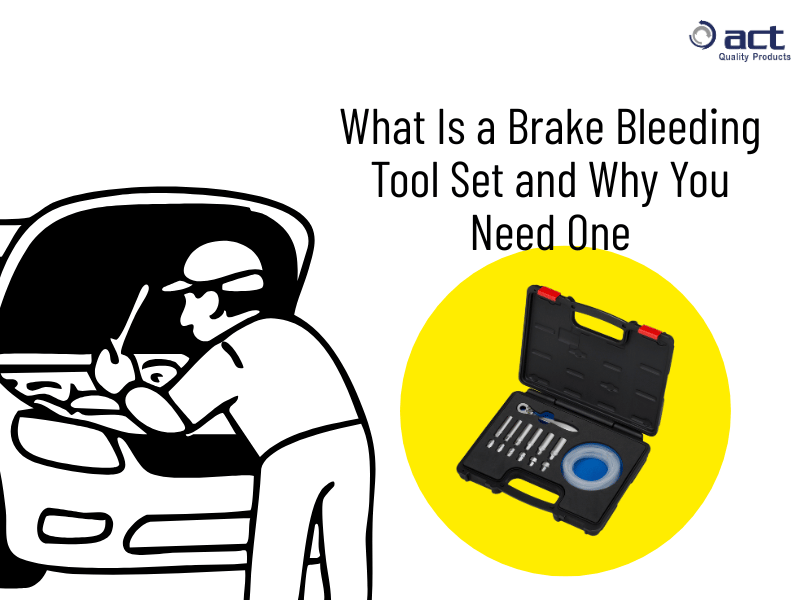2025-11-17
What Is a Brake Bleeding Tool Set and Why You Need One

A Complete Guide to Efficient Brake System Maintenance
Modern hydraulic braking systems are highly efficient, but even the best systems require proper maintenance to ensure safe and responsive braking. One crucial process in brake maintenance is bleeding the brakes—removing air bubbles and old brake fluid from the system. To do this effectively and safely, technicians and DIY enthusiasts use a Brake Bleeding Tool Set.
In this article, we’ll explain what a brake bleeding tool set is, why it’s essential, what components are typically included, and how to use it properly.
What Is a Brake Bleeding Tool Set?
A Brake Bleeding Tool Set is a specialized kit designed to remove air and old fluid from a vehicle’s hydraulic brake system. Air trapped in the brake lines can significantly reduce braking efficiency because air compresses under pressure, while brake fluid does not. Even a small amount of air can cause a soft or spongy brake pedal feel and pose serious safety risks.
Brake bleeding kits make it easy to flush out old brake fluid and eliminate trapped air, ensuring the system is filled only with clean, bubble-free hydraulic fluid.
Why Is Brake Bleeding Important?
- Restores Brake Responsiveness: Removes compressible air from the system.
- Prevents Brake Failure: Ensures hydraulic pressure is transferred fully to brake calipers.
- Extends Component Life: Old brake fluid absorbs moisture, which can corrode brake lines and reduce performance.
- Ensures Safe Driving: Inconsistent brake pressure can result in delayed stopping distances—dangerous in emergencies.
Even professional repair shops regularly use brake bleeding tools to maintain performance in both passenger vehicles and performance vehicles.
What's Inside This Brake Bleeding Tool Set?
This specific Brake Bleeding Tool Set includes essential components for both beginners and professionals, making brake bleeding more efficient and precise:
| Component | Description |
|---|---|
| 1 PC – 11H Mini Wrench | Compact wrench designed for loosening and tightening bleeder valves easily, even in tight spaces. |
| 1 PC – 4mm x 7mm x 750mm Transparent Silicone Tube | High-clarity flexible tube for fluid and air evacuation; lets you observe bubbles and flow rate. |
| 6 PCS – 11H 25mmL Standard Sockets (Sizes: 7-8-9-10-11-12 mm) |
Short sockets designed for use with the mini wrench; compatible with most common brake bleeder nipples. |
| 6 PCS – 11H 50mmL Long Sockets (Sizes: 7-8-9-10-11-12 mm) |
Extended sockets for better reach and control on recessed or hard-to-access valves. |
All components are crafted for durability, compatibility, and ease of use in both workshop and field environments.
Types of Brake Bleeding Methods Supported
- Manual Two-Person Bleeding: One person presses the brake pedal while the other opens and closes the bleeder valve.
- One-Person Gravity Bleeding: Relies on gravity and check valves for slow bleeding.
- Vacuum Bleeding: Uses suction to pull fluid and air out—ideal for solo work.
- Pressure Bleeding: Pressurizes the master cylinder to push fluid through—efficient for full system flushes.
Many modern vehicles with ABS or regenerative braking systems require precise bleeding and may benefit from vacuum or pressure-type bleeding kits.
Tips for Safe and Effective Brake Bleeding
- Use the correct brake fluid type: DOT 3, DOT 4, DOT 5.1, or manufacturer-specific formulas.
- Do not reuse old fluid: Brake fluid absorbs moisture and loses performance over time.
- Bleed in proper sequence: Typically from the farthest wheel to the closest (RR → LR → RF → LF), but always check vehicle specs.
- Prevent contamination: Use clean tools, and avoid introducing water, oil, or dust into the reservoir.
- Monitor for leaks: Check bleeder screws and connections for fluid seepage during and after the process.
How Often Should You Bleed the Brakes?
- Passenger Cars: Every 2 years or 30,000–50,000 km.
- Performance Vehicles / Motorsports: Every few races or track events.
- Motorcycles / Bicycles: At least annually, or if lever feels soft.
- After Repair Work: Always bleed after replacing master cylinder, calipers, hoses, or lines.
Final Thoughts: A Must-Have for Any Workshop
A Brake Bleeding Tool Set is an essential addition to any professional workshop or home mechanic’s toolbox. It ensures brake systems perform at peak levels and helps prevent common issues like brake fade, pedal sponginess, or total brake failure.
Whether you’re servicing a single car or maintaining an entire fleet, investing in the right bleeding kit will save you time, ensure safety, and extend the life of your braking components.
Need More Information?
Let us know your vehicle type and maintenance needs—we’ll help you select the perfect brake bleeding tool set for your shop or garage.
Contact us here
